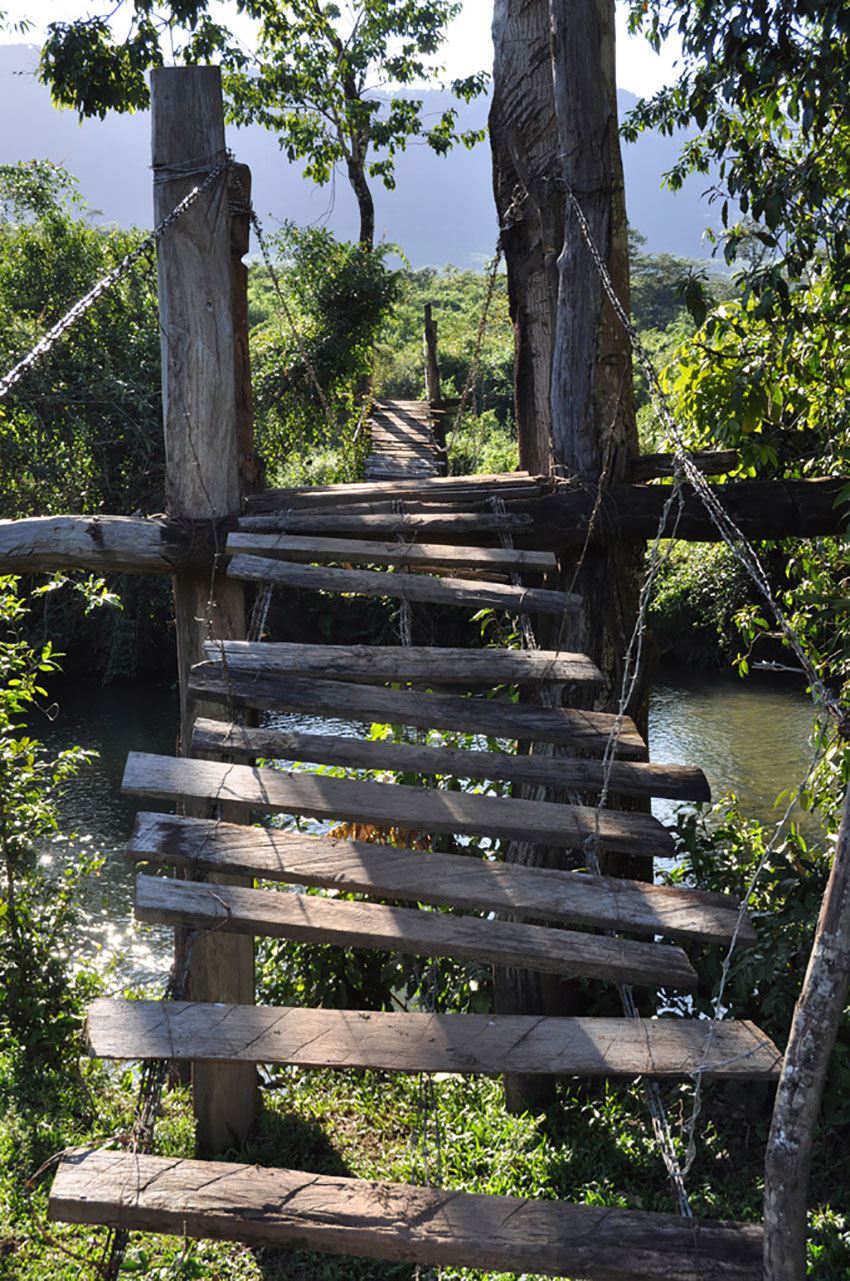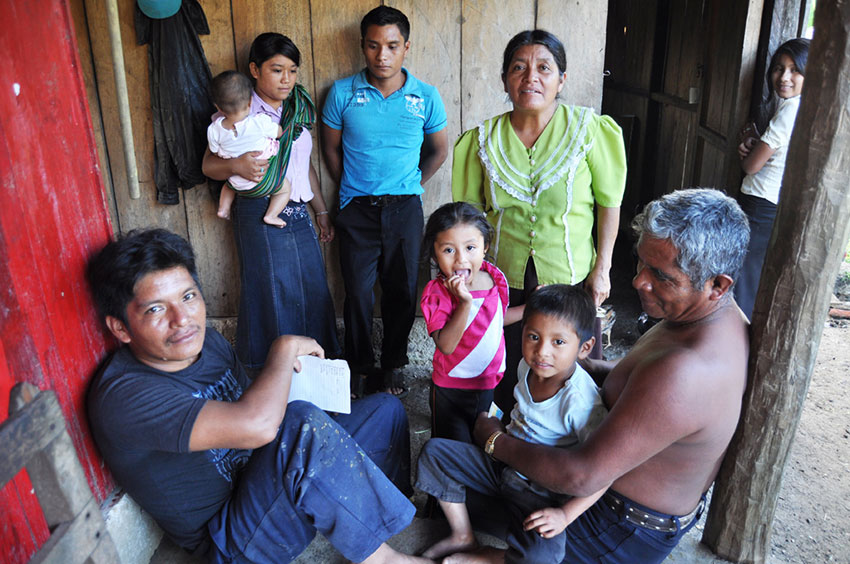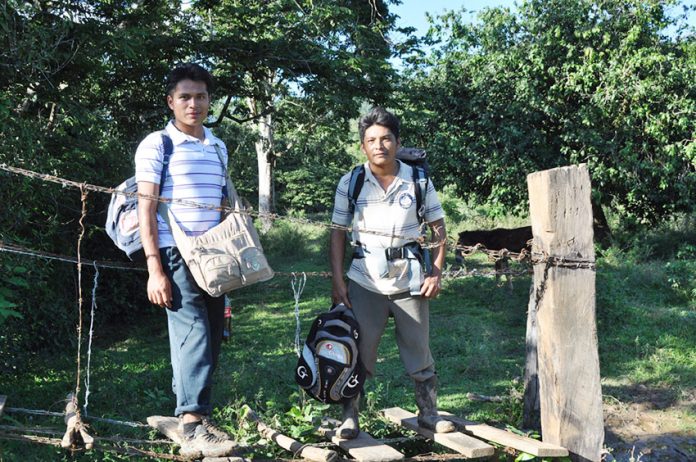Armando is standing outside my hotel room in Las Margaritas, a pueblo in Chiapas, looking unconvinced. He had asked if I could hike the 1 1/2 hours to Benito Juárez the next day.
“Yes,” I tell him.
“Well,” he says, “we will see.” He’s not instilling confidence.
The next day, he shows up with Fredy, my guide. Fredy doesn’t seem real happy to meet me, barely acknowledging my presence. In silence, we walk to where a camioneta waits, climb in and head out.
After a four-hour drive, we get out and begin the hike. I ask Fredy how long we have to walk. “Una hora,” he says: one hour.
We begin walking on a hard-packed dirt road and I begin to relax — the hike is more like an easy stroll. I’m in such a good mood that I try to engage Fredy in conversation.
“Are you married, Fredy?”
“Sí.”
“Do you have children?”
“Sí.”
“How many?”

“Tres.”
“How much longer do we have to walk?”
“Una hora más.”
We’d already been walking close to an hour but whenever I ask how much longer, he says una hora más. I nickname him, Señor Una Hora Más.
After another hour, we stop at a small store, have a couple of Cokes and are met by Isaías, who insists on carrying my backpack. I grab my camera bag and we’re off.
We leave the hard-packed dirt road and begin walking on a hilly trail that’s often ankle-deep mud. Now, my idea of climbing a hill is to go at it as hard as I can for as long as I can so I can put it behind me. It’s painful but quick.
As I’m slipping and sliding my way uphill, Isaís calls out, “Despacio, señor, despacio.” Slowly, sir, slowly. At the top of one climb I stop, bent over and panting. “Señor,” says Isaías, “en el campo, lento es mejor.” In the country, slow is better. I gotta admit he was right but I keep pushing.
At some point, we come across a bridge. And I use the word “bridge” in the broadest possible sense. Let’s just say it’s a loosely constructed thing spanning a river. It doesn’t look very safe. In fact, it looks terrifyingly dangerous. I take one look at this thing and have two thoughts: one is that I’m very glad Benito Juárez is on this side of the river so we don’t have to cross it.
I think this even though I haven’t a clue where Benito Juárez is. The second thought is that if I keep walking and ignore it, they’ll also ignore it. My strategy doesn’t work. Isaías calls to me from the foot of the bridge. He signals me to return. I do and he simply gestures toward the bridge, indicating we have to cross it. I look and the only word that comes to mind is, “Fuck.”
This “bridge” is 20 or 25 feet above a river that’s about 50 feet wide. I can’t tell how deep the water is but it’s moving rapidly. The bridge is held together by barbed wire. You walk on thin boards and narrow tree limbs which, in spots, are separated by a couple of feet. I figure I’m going to die but I will my legs to begin walking. My jaw is clenched and my throat is parched.
I’m so terrified that I can’t bend my legs, so I’m doing a Frankenstein imitation. I cling tightly to the guide wires as I walk, the barbs digging into my hands. As I cross, I no longer think I’m going to die; I’m certain I’m going to die. I keep my eyes peeled to the boards and command my legs to keep moving. If I stop, I’ll never be able to start again. Below, I can see the river rushing by. That increases my fear, so I look up only notice that the bridge is twisted at an uncomfortable angle. I decide not to look up again.

I somehow make it across. My hands are covered with blood, pierced by the barbed wire. I swab alcohol and antibiotic on the cuts and hope my tetanus shot is up to date. As I kneel on the ground, Isaís comes over. “Debe agarrar suave, señor, suave.” You must hold on gently. I nod but think, “Right. One of those boards breaks, hanging onto that barbed wire is the only thing that will save me.”
I want to take a photo of the bridge but am still so scared that I can’t make myself get close enough but I do get a couple of shots of Isaís and Fredy standing beside it. They’re smiling.
They insist I ride the rest of the way to Benito Juárez on a horse. I somehow manage not to fall off.
I was only allowed to stay there two days. It’s a Zapatista autonomous area and a dicey place for me to be. Once I’d settled in, everyone — including Fredy — turned out to be friendly. The village has no electricity and at night families gather by flashlight or candlelight to talk and laugh.
On the second day, I mention to Isaías that I was afraid to cross that bridge again. I didn’t know if my luck would hold out for a second crossing.
“I weigh much more than you do,” I said. “With my equipment, it’s probably close to 90 kilos.”
“I understand,” he replied. “Some time ago, my cousin was crossing that bridge, carrying corn. A board broke. He died.”
I thanked him for telling me that story but I don’t think my sarcasm translated well.
“There is another way to go,” he continued. “It’s much farther and it will cost about 1,000 pesos. I can make a phone call.”
I tell him I’ll think about it. It only cost 120 pesos for Fredy and me on the way in but then I realize that my life’s certainly worth 1,000 pesos — about US $85 at the time. I tell him I’ll take the alternative route out.
When we leave, they put me on a mule for the entire trek with Daniel carrying my cameras, Isaías my backpack. I feel guilty but they won’t let me walk or carry anything. As we make our way, I notice places we’d passed on the way in. It appears to be the same route. Then I see the bridge. I think about taking a photo but decide if we stop they may make me cross it again.
We cross the river a couple hundred feet from the bridge and the water is never more than a couple of feet deep. I’m completely stunned. The only thing I can think is that the hike in was a test, which has happened to me before. If I had refused to walk over that bridge, we probably would have crossed downstream but my stay would have been completely different. But later I tell Isaías that when I return, there’s no way in hell I’ll cross “El Puente de la Muerte,” the bridge of death.
And the return trip only cost me 120 pesos, not the 1,000 I was told.
Joseph Sorrentino lives in San Gregorio Atlapulco, Mexico City, and is a regular contributor to Mexico News Daily.
